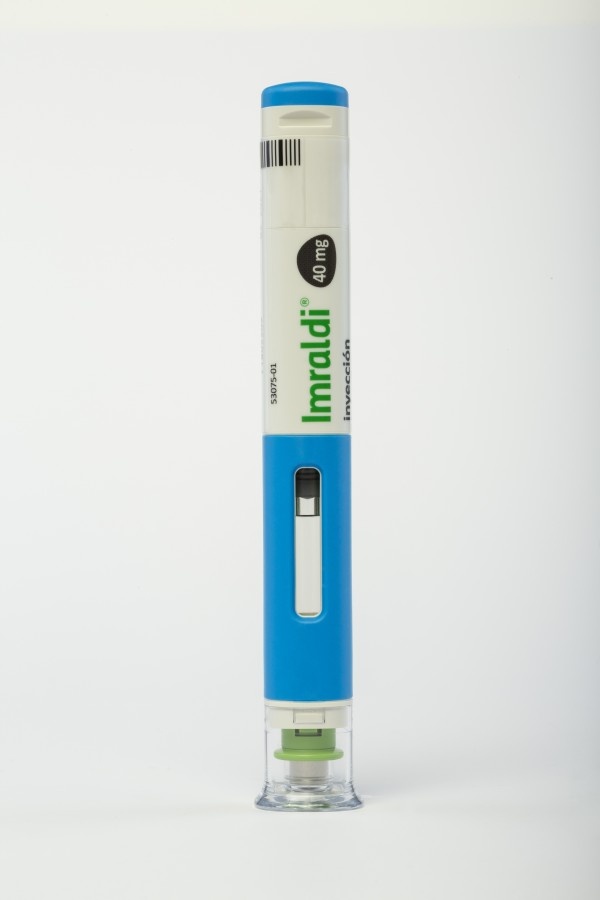
How to use IMRALDI 40 mg SOLUTION FOR INJECTION IN PRE-FILLED PEN
Introduction
Package Leaflet: Information for the Patient
Imraldi 40 mg Solution for Injection in Pre-filled Pen
adalimumab
Read all of this leaflet carefully before you start using this medicine because it contains important information for you.
- Keep this leaflet, you may need to read it again.
- Your doctor will also give you a patient information card, which contains important safety information that you need to know before and during treatment with Imraldi. Keep this patient information card during your treatment and for 4 months after your last injection (or your child's) of Imraldi.
- If you have any further questions, ask your doctor or pharmacist.
- This medicine has been prescribed for you only. Do not pass it on to others. It may harm them, even if their symptoms are the same as yours.
- If you experience any side effects, talk to your doctor or pharmacist. This includes any possible side effects not listed in this leaflet. See section 4.
Contents of the Package Leaflet
- What is Imraldi and what is it used for
- What you need to know before you start using Imraldi
- How to use Imraldi
- Possible side effects
- Storage of Imraldi
- Contents of the pack and further information
- Instructions for use
1. What is Imraldi and what is it used for
Imraldi contains the active substance adalimumab, a medicine that works on the immune system (the body's defense system).
Imraldi is indicated for the treatment of:
- rheumatoid arthritis,
- juvenile idiopathic polyarticular arthritis,
- enthesitis-related arthritis,
- ankylosing spondylitis,
- axial spondyloarthritis without radiographic evidence of ankylosing spondylitis,
- psoriatic arthritis,
- psoriasis,
- hidradenitis suppurativa,
- Crohn's disease,
- ulcerative colitis, and
- non-infectious uveitis.
The active substance in Imraldi, adalimumab, is a monoclonal antibody. Monoclonal antibodies are proteins that bind to a specific target.
The target of adalimumab is a protein (called tumor necrosis factor (TNFα), whose levels increase in the inflammatory diseases indicated above. By binding to TNFα, Imraldi reduces the inflammation process in these diseases.
Rheumatoid Arthritis
Rheumatoid arthritis is an inflammatory disease of the joints.
Imraldi is used to treat rheumatoid arthritis in adults. If you have moderate to severe active rheumatoid arthritis, you may have been given other medicines that modify the disease, such as methotrexate, before. If the effect of these medicines is not good enough, you will be given Imraldi to treat your rheumatoid arthritis.
Imraldi can also be used to treat severe, active, and progressive rheumatoid arthritis without previous treatment with methotrexate.
Imraldi can reduce the damage to the cartilage and bones of the joints caused by the disease and improve physical function.
Imraldi is usually used in combination with methotrexate. If your doctor considers that methotrexate is not appropriate, Imraldi can be given alone.
Juvenile Idiopathic Polyarticular Arthritis and Enthesitis-Related Arthritis
Juvenile idiopathic polyarticular arthritis and enthesitis-related arthritis are inflammatory diseases of the joints that usually occur in childhood.
Imraldi is used to treat juvenile idiopathic polyarticular arthritis in children and adolescents from 2 to 17 years of age and enthesitis-related arthritis in children from 6 to 17 years of age. Patients may have received other disease-modifying medicines, such as methotrexate, before. If the effect of these medicines is not good enough, patients will be given Imraldi to treat their juvenile idiopathic polyarticular arthritis or enthesitis-related arthritis.
Ankylosing Spondylitis and Axial Spondyloarthritis without Radiographic Evidence of Ankylosing Spondylitis
Ankylosing spondylitis and axial spondyloarthritis without radiographic evidence of ankylosing spondylitis are inflammatory diseases that affect the spine.
Imraldi is used to treat ankylosing spondylitis and axial spondyloarthritis without radiographic evidence of ankylosing spondylitis in adults. If you have ankylosing spondylitis or axial spondyloarthritis without radiographic evidence of ankylosing spondylitis, you will be treated first with other medicines and if the effect of these medicines is not good enough, you will be given Imraldi to reduce the signs and symptoms of your disease.
Psoriatic Arthritis
Psoriatic arthritis is an inflammatory disease of the joints associated with psoriasis.
Imraldi is used to treat psoriatic arthritis in adults. Imraldi can reduce the joint damage caused by the disease in the cartilage and bone and improve physical function.
Plaque Psoriasis in Adults and Children
Plaque psoriasis is an inflammatory disease of the skin that causes red, scaly, crusty, and silvery-scaled areas. Plaque psoriasis can also affect the nails, causing them to deteriorate, thicken, and lift off the nail bed, which can be painful. It is believed that psoriasis is caused by a defect in the body's immune system that leads to an increase in the production of skin cells.
Imraldi is used to treat moderate to severe plaque psoriasis in adults. Imraldi is also used to treat severe plaque psoriasis in children and adolescents with a weight of 30 kg or more who have not responded to or are not candidates for topical therapy and phototherapy.
Hidradenitis Suppurativa in Adults and Adolescents
Hidradenitis suppurativa (also known as inverse acne) is a long-term and often painful inflammatory disease of the skin. Symptoms can include painful nodules (lumps) and abscesses (boils) that can secrete pus. It usually affects specific areas of the skin, such as under the breast, armpits, inner thighs, groin, and buttocks. There can also be scarring in the affected areas.
Imraldi is used to treat hidradenitis suppurativa in adults and adolescents from 12 years of age. Imraldi can reduce the number of nodules and abscesses and the pain that is usually associated with the disease. You may have received other medicines before. If the effect of these medicines is not good enough, you will be given Imraldi.
Crohn's Disease in Adults and Children
Crohn's disease is an inflammatory disease of the digestive tract.
Imraldi is used to treat Crohn's disease in adults and children from 6 to 17 years of age. If you have Crohn's disease, you will be treated first with other medicines. If the effect is not good enough, you will be given Imraldi to reduce the signs and symptoms of Crohn's disease.
Ulcerative Colitis in Adults and Children
Ulcerative colitis is an inflammatory disease of the large intestine.
Imraldi is used to treat moderate to severe ulcerative colitis in adults and children from 6 to 17 years of age. If you have ulcerative colitis, you may be given other medicines first. If the effect is not good enough, you will be given Imraldi to reduce the signs and symptoms of your disease.
Non-Infectious Uveitis in Adults and Children
Non-infectious uveitis is an inflammatory disease that affects certain parts of the eye. Imraldi is used to treat
- adults with non-infectious uveitis with inflammation that affects the back of the eye.
- children from 2 years of age with chronic non-infectious uveitis with inflammation that affects the front of the eye.
This inflammation can lead to a decrease in vision and/or the presence of floaters in the eye (black dots or thin lines that move along the field of vision). Imraldi works by reducing this inflammation.
2. What you need to know before you start using Imraldi
Do not use Imraldi
- If you are allergic to adalimumab or to any of the other components of this medicine (listed in section 6).
- If you have a severe infection, including tuberculosis (see “Warnings and precautions”). If you have symptoms of any infection, such as fever, wounds, fatigue, dental problems, it is important that you inform your doctor.
- If you have moderate or severe heart failure. It is important that you tell your doctor if you have had or have any serious heart problems (see “Warnings and precautions”).
Warnings and precautions
Consult your doctor or pharmacist before starting to use Imraldi.
Allergic reaction
- If you have an allergic reactionwith symptoms such as chest tightness, difficulty breathing, dizziness, swelling, or rash, stop administering Imraldi and contact your doctor immediately, as these reactions can be life-threatening in rare cases.
Infection
- If you have any infection, including chronic or localized infections (e.g., a leg ulcer), consult your doctor before starting treatment with Imraldi. If you are unsure, contact your doctor.
- With Imraldi treatment, you may be more likely to get infections. This risk may be higher if you have reduced lung function. These infections can be serious and include tuberculosis, viral, fungal, parasitic, or bacterial infections, other opportunistic infections (rare infections associated with a weakened immune system), and sepsis (blood poisoning). In rare cases, these infections can be life-threatening. Therefore, it is essential that if you have symptoms such as fever, wounds, fatigue, or dental problems, you tell your doctor. Your doctor may recommend that you temporarily stop treatment with Imraldi.
Tuberculosis
- Since cases of tuberculosis have been reported in patients treated with Imraldi, your doctor will examine you for signs or symptoms of tuberculosis before starting your treatment with Imraldi. This will include a thorough medical evaluation, including your medical history and diagnostic tests (e.g., chest X-ray and tuberculin test). The performance and results of these tests should be recorded on your patient information card. It is crucial that you inform your doctor if you have had tuberculosis or have been in contact with a tuberculosis patient. Tuberculosis can develop during treatment, even if you have received preventive treatment for tuberculosis. If symptoms of tuberculosis (persistent cough, weight loss, general malaise, low-grade fever) or any other infection appear during or after treatment, contact your doctor immediately.
Travel/recurring infection
- Tell your doctor if you have lived or traveled to regions where fungal infections such as histoplasmosis, coccidioidomycosis, or blastomycosis are endemic.
- Tell your doctor if you have a history of recurring infections or other conditions or factors that increase the risk of infections.
Hepatitis B virus
- Tell your doctor if you are a carrier of the hepatitis B virus (HBV), if you have had an active HBV infection, or if you think you may be at risk of contracting HBV. Your doctor should perform an HBV test. Imraldi may reactivate HBV infection in people carrying this virus. In rare cases, especially if you are taking other medications that suppress the immune system, HBV reactivation can be life-threatening.
Patient over 65 years old
- If you are over 65 years old, you may be more susceptible to infections while being treated with Imraldi. Both you and your doctor should pay special attention to the appearance of signs of infection while being treated with Imraldi. It is essential that you inform your doctor if you have symptoms of infections, such as fever, wounds, feeling of fatigue, or dental problems.
Surgical or dental intervention
- If you are going to have a surgical or dental procedure, inform your doctor that you are taking Imraldi. Your doctor may recommend that you temporarily stop treatment with Imraldi.
Demyelinating disease
- If you have or develop a demyelinating disease(a disease that affects the insulating layer surrounding the nerves, such as multiple sclerosis), your doctor will decide whether you should be treated or continue treatment with Imraldi. Inform your doctor immediately if you experience symptoms such as changes in vision, weakness in arms or legs, or numbness or tingling in any part of the body.
Vaccines
- Certain vaccinescontain live, albeit weakened, forms of bacteria or viruses that cause diseases, and these vaccines should not be administered during treatment with Imraldi. Consult your doctor before administering any type of vaccine. If possible, administer all scheduled vaccines to children before starting treatment with Imraldi. If you receive Imraldi while pregnant, your child may have a higher risk of infection for about 5 months after the last dose of Imraldi you received during pregnancy. It is essential that you inform your child's doctor and other healthcare professionals about your use of Imraldi during pregnancy, so they can decide whether your child should receive any vaccine.
Heart failure
- If you have mild heart failureand are being treated with Imraldi, your doctor should continuously monitor your heart failure. It is essential that you inform your doctor if you have had or have serious heart problems. If new symptoms of heart failure appear or existing ones worsen (e.g., difficulty breathing or swelling of the feet), you should contact your doctor immediately. Your doctor will decide whether you should continue taking Imraldi.
Fever, bruising, bleeding, or pale appearance
- In some patients, the body may be unable to produce a sufficient number of the type of blood cells that fight infections (white blood cells) or those that help stop bleeding (platelets). If you have persistent feveror suffer from bruisingor bleedingvery easily or are very pale, consult your doctor immediately. Your doctor may decide to interrupt treatment.
Cancer
- In very rare cases, certain types of cancerhave been reported in children and adults treated with Imraldi or other TNF-alpha blockers. People with severe rheumatoid arthritis who have had the disease for a long time may have a higher-than-average risk of developing lymphoma(a cancer that affects the lymphatic system) and leukemia (a cancer that affects the blood and bone marrow). If you are being treated with Imraldi, the risk of lymphoma, leukemia, and other types of cancer may increase. A specific and severe type of lymphoma has been observed in rare cases in patients treated with Imraldi. Some of these patients were also receiving treatment with azathioprine or mercaptopurine. Inform your doctor if you are taking azathioprine or mercaptopurine with Imraldi.
- Additionally, cases of non-melanoma skin cancerhave been observed in patients using Imraldi. Notify your doctor if new areas of damaged skin appear or if marks or damaged areas change in appearance during or after treatment.
- Cancers other than lymphomahave been reported in patients with a specific lung disease called chronic obstructive pulmonary disease (COPD) treated with another TNF-alpha blocker. If you have COPD or are a heavy smoker, you should consult your doctor to determine if treatment with a TNF-alpha blocker is suitable for you.
Lupus-like syndrome
- In rare cases, treatment with Imraldi may lead to a lupus-like syndrome. Contact your doctor if you experience symptoms such as unexplained persistent rash, fever, joint pain, or fatigue.
Children and adolescents
- Do not administer Imraldi to children under 2 years old with polyarticular juvenile idiopathic arthritis.
- Do not use the 40 mg pre-filled pen if doses other than 40 mg are recommended.
Other medicines and Imraldi
Tell your doctor or pharmacist if you are taking, have recently taken, or might take any other medicines.
Imraldi can be taken with methotrexate or with certain disease-modifying antirheumatic drugs (sulfasalazine, hydroxychloroquine, leflunomide, and injectable gold salts), steroids, or pain medications, including non-steroidal anti-inflammatory drugs (NSAIDs).
Do not use Imraldi with medicines whose active substances are anakinra or abatacept due to an increased risk of serious infections. If you are unsure, consult your doctor.
Pregnancy and breastfeeding
- You should consider using adequate contraceptive methods to avoid becoming pregnant and continue using them for at least 5 months after the last Imraldi injection.
- If you are pregnant, think you may be pregnant, or plan to have a baby, ask your doctor for advice before using this medicine.
- Imraldi should be used during pregnancy only if necessary.
- According to a pregnancy study, there was no increased risk of congenital defects when the mother had received adalimumab treatment during pregnancy compared to mothers with the same disease who did not receive adalimumab treatment.
- Imraldi can be used during breastfeeding.
- If you use Imraldi while pregnant, your child may have a higher risk of infection.
- It is essential that you inform your child's doctor and other healthcare professionals about your use of Imraldi during pregnancy before your child receives any vaccine. For more information on vaccines, see the “Warnings and precautions” section.
Driving and using machines
Imraldi's influence on the ability to drive, ride a bicycle, or use machines is small. You may experience dizziness (vertigo) and vision disturbances after taking Imraldi.
Imraldi contains sodium and sorbitol
Sorbitol
This medicine contains 20 mg of sorbitol in each pre-filled pen. If your doctor has informed you that you have an intolerance to certain sugars, contact them before taking this medicine.
Sodium
This medicine contains less than 1 mmol of sodium (23 mg) per 0.8 ml dose; it is essentially “sodium-free”.
3. How to use Imraldi
Follow exactly the administration instructions of this medication as indicated by your doctor or pharmacist. In case of doubt, consult your doctor or pharmacist again.
Adults with rheumatoid arthritis, psoriatic arthritis, ankylosing spondylitis, or axial spondyloarthritis without radiographic evidence of ankylosing spondylitis
Imraldi in pre-filled syringe and pre-filled pen is only available in 40 mg doses. Therefore, it is not possible to administer Imraldi in pre-filled syringe or pre-filled pen to pediatric patients who require less than a full 40 mg dose. When an alternative dose is required, other presentations that offer this option should be used.
Imraldi is injected under the skin (subcutaneously). The normal dose in adults with rheumatoid arthritis, ankylosing spondylitis, axial spondyloarthritis without radiographic evidence of ankylosing spondylitis, and for patients with psoriatic arthritis is 40 mg of adalimumab administered every other week as a single dose.
In the case of rheumatoid arthritis, treatment with methotrexate is maintained during the use of Imraldi. If your doctor determines that methotrexate is inappropriate, Imraldi can be administered alone.
If you have rheumatoid arthritis and do not receive methotrexate during your treatment with Imraldi, your doctor may decide to give you 40 mg of adalimumab every week or 80 mg every two weeks.
Children, adolescents, and adults with polyarticular juvenile idiopathic arthritis
Children and adolescents from 2 years of age with 10 kg of weight up to 30 kg
The recommended dose of Imraldi is 20 mg every other week.
Children, adolescents, and adults from 2 years of age with a weight of 30 kg or more
The recommended dose of Imraldi is 40 mg every other week.
Children, adolescents, and adults with enthesitis-related arthritis
Children and adolescents from 6 years of age with 15 kg of weight up to 30 kg
The recommended dose of Imraldi is 20 mg every other week.
Children, adolescents, and adults from 6 years of age with a weight of 30 kg or more
The recommended dose of Imraldi is 40 mg every other week.
Adults with psoriasis
The normal dosage in adults with psoriasis consists of an initial dose of 80 mg (as two 40 mg injections on one day), followed by 40 mg every other week starting one week after the initial dose. You should continue injecting Imraldi for as long as your doctor has indicated. If this dose is not effective enough, your doctor may increase the dose to 40 mg weekly or 80 mg every two weeks.
Children and adolescents with plaque psoriasis
Children and adolescents from 4 to 17 years of age with 15 kg of weight up to 30 kg
The recommended dose of Imraldi is an initial dose of 20 mg followed by 20 mg one week later. From then on, the usual dose is 20 mg every other week.
Children and adolescents from 4 to 17 years of age with a weight of 30 kg or more
The recommended dose of Imraldi is an initial dose of 40 mg, followed by 40 mg one week later. From then on, the usual dose is 40 mg every other week.
Adults with hidradenitis suppurativa
The usual dosage regimen for hidradenitis suppurativa is an initial dose of 160 mg (as four 40 mg injections on one day or two 40 mg injections per day for two consecutive days) followed by a dose of 80 mg (as two 40 mg injections on one day) two weeks later. After two more weeks, continue with a dose of 40 mg weekly or 80 mg every two weeks, as prescribed by your doctor. It is recommended that you use an antiseptic liquid daily on the affected areas.
Adolescents with hidradenitis suppurativa from 12 to 17 years of age, with a weight of 30 kg or more
The recommended dose of Imraldi is an initial dose of 80 mg (as two 40 mg injections on one day), followed by 40 mg every other week starting one week later. If you have an inadequate response to Imraldi 40 mg every other week, your doctor may increase the dose to 40 mg weekly or 80 mg every two weeks.
It is recommended that you use an antiseptic liquid daily on the affected areas.
Adults with Crohn's disease
The usual dosage regimen for Crohn's disease is 80 mg (as two 40 mg injections on one day) initially, followed by 40 mg every other week starting two weeks later.
If a faster effect is required, your doctor may prescribe an initial dose of 160 mg (as four 40 mg injections on one day or two 40 mg injections per day for two consecutive days), followed by 80 mg (as two 40 mg injections on one day) two weeks later, and then 40 mg every other week. If the effect of this dose is not sufficient, your doctor may increase the dose to 40 mg weekly or 80 mg every two weeks.
Children and adolescents with Crohn's disease
Children and adolescents from 6 to 17 years of age with a weight less than 40 kg
The usual dosage regimen is 40 mg initially, followed by 20 mg two weeks later. If a faster response is required, your doctor may prescribe an initial dose of 80 mg (as two 40 mg injections on one day) followed by 40 mg two weeks later.
From then on, the usual dose is 20 mg every other week. If this dose is not effective enough, your doctor may increase the frequency of the dose to 20 mg weekly.
Children and adolescents from 6 to 17 years of age with a weight of 40 kg or more:
The usual dosage regimen is 80 mg (as two 40 mg injections on one day) initially, followed by 40 mg two weeks later. If a faster response is required, your doctor may prescribe an initial dose of 160 mg (as four 40 mg injections on one day or two 40 mg injections per day for two consecutive days) followed by 80 mg (as two 40 mg injections on one day) two weeks later.
From then on, the usual dose is 40 mg every other week. If the effect of this dose is not sufficient, your doctor may increase the dose to 40 mg weekly or 80 mg every two weeks.
Adults with ulcerative colitis
The usual dosage regimen of Imraldi in adults with ulcerative colitis is 160 mg initially (the dose can be administered as four injections on one day or with two 40 mg injections per day for two consecutive days) followed by 80 mg (as two 40 mg injections on one day) two weeks later, and then 40 mg every other week. If the effect of this dose is not sufficient, your doctor may increase the dose to 40 mg weekly or 80 mg every two weeks.
Children and adolescents with ulcerative colitis
Children and adolescents from 6 years of age with a weight less than 40 kg
The usual dose of Imraldi is 80 mg (as two 40 mg injections on one day) initially, followed by a dose of 40 mg (as one 40 mg injection) two weeks later. From then on, the usual dose is 40 mg every other week.
Patient who reach 18 years of age while receiving treatment with 40 mg every other week should continue with their prescribed dose.
Children and adolescents from 6 years of age with a weight of 40 kg or more
The usual dose of Imraldi is 160 mg (as four 40 mg injections on one day or two 40 mg injections per day for two consecutive days) initially, followed by a dose of 80 mg (as two 40 mg injections on one day) two weeks later. From then on, the usual dose is 80 mg every other week.
Patient who reach 18 years of age while receiving treatment with 80 mg every other week should continue with their prescribed dose.
Adults with non-infectious uveitis
The usual dosage regimen in adults with non-infectious uveitis is 80 mg (as two injections on one day) initially, followed by 40 mg every other week starting one week after the initial dose. Continue injecting Imraldi for the time indicated by your doctor.
In non-infectious uveitis, the administration of corticosteroids or medications that act on the immune system can be continued during the use of Imraldi. Imraldi can also be administered alone.
Children and adolescents from 2 years of age with chronic non-infectious uveitis
Children and adolescents from 2 years of age with a weight less than 30 kg
The usual dose of Imraldi is 20 mg every other week, along with methotrexate.
Your pediatrician may prescribe an initial dose of 40 mg that can be administered one week before starting the usual regimen.
Children and adolescents from 2 years of age with a weight of 30 kg or more
The usual dose of Imraldi is 40 mg every other week, along with methotrexate.
Your doctor may prescribe an initial dose of 80 mg that can be administered one week before starting the usual regimen.
Form and route of administration
Imraldi is injected under the skin (subcutaneously). For instructions for use, see section 7.
If you use more Imraldi than you should:
If you accidentally inject Imraldi more frequently than you should, you must inform your doctor or pharmacist that you have used more than necessary. Always carry the medication box with you, even if it is empty.
If you forget to use Imraldi:
If you forget to administer an injection, you should inject the next dose of Imraldi as soon as you remember. Then, the next dose will be administered as usual, as if you had not forgotten a dose.
If you interrupt treatment with Imraldi:
The decision to stop using Imraldi should be discussed with your doctor. Your symptoms may return after interrupting treatment.
If you have any other questions about the use of this medication, ask your doctor or pharmacist.
4. Possible Adverse Effects
Like all medicines, this medicine can cause adverse effects, although not all people suffer from them. Most adverse effects are mild to moderate. However, some can be serious and require treatment. Adverse effects may appear up to 4 months or more after the last injection of Imraldi.
Seek medical attention urgentlyif you notice any of the following effects:
- severe rash, hives, or other signs of allergic reaction;
- swelling of the face, hands, feet;
- difficulty breathing, swallowing;
- shortness of breath when exercising or lying down, swelling of feet.
Contact your doctor as soon as possibleif you notice any of the following effects:
- signs of infection such as fever, nausea, wounds, dental problems, burning sensation when urinating;
- feeling of weakness or fatigue;
- cough;
- tingling;
- numbness;
- double vision;
- weakness in arms or legs;
- a lump or an open wound that does not heal;
- signs and symptoms of blood disorders such as persistent fever, bruising, bleeding, and pallor.
The symptoms described above may be signs of the adverse effects listed below, which have been observed with adalimumab:
Very Common(may affect more than 1 in 10 people):
- reactions at the injection site (including pain, swelling, redness, or itching);
- lower respiratory tract infections (including colds, runny nose, sinusitis, pneumonia);
- headache;
- abdominal pain (stomach);
- nausea and vomiting;
- rash;
- muscle pain.
Common(may affect up to 1 in 10 people):
- severe infections (including sepsis and flu);
- intestinal infections (including gastroenteritis);
- skin infections (including cellulitis and herpes);
- ear infection;
- mouth infections (including dental infection and cold sore);
- infections of the reproductive system;
- urinary tract infections;
- fungal infections;
- joint infections;
- benign tumors;
- skin cancer;
- allergic reactions (including seasonal allergy);
- dehydration;
- mood changes (including depression);
- anxiety;
- difficulty sleeping;
- sensory disturbances such as tingling, itching, or numbness;
- migraine;
- symptoms of nerve root compression (including lower back pain and leg pain);
- visual disturbances;
- eye inflammation;
- eyelid inflammation and eye swelling;
- vertigo (feeling that the room is spinning);
- feeling of rapid heartbeat;
- high blood pressure;
- flushing;
- hematoma (a palpable swelling with clotted blood);
- cough;
- asthma;
- difficulty breathing;
- gastrointestinal bleeding;
- dyspepsia (indigestion, bloating, and heartburn);
- acid reflux;
- dry eye syndrome (including dryness in eyes and mouth);
- itching;
- pruritic rash;
- bruising;
- skin inflammation (such as eczema);
- breaking of fingernails and toenails;
- increased sweating;
- hair loss;
- new onset or worsening of psoriasis;
- muscle spasms;
- blood in urine;
- kidney problems;
- chest pain;
- edema (fluid accumulation in the body that causes swelling of the affected tissue);
- fever;
- low platelet count in blood, which increases the risk of bleeding or bruising;
- wound healing problems.
Uncommon(may affect up to 1 in 100 people):
- opportunistic infections (including tuberculosis and other infections that occur when disease resistance decreases);
- neurological infections (including viral meningitis);
- eye infections;
- bacterial infections;
- diverticulitis (inflammation and infection of the large intestine);
- cancer, including lymphoma and melanoma (a type of skin cancer);
- immune system disorders that can affect the lungs, skin, and lymph nodes (most frequently as a disease called sarcoidosis);
- vasculitis (inflammation of blood vessels);
- tremor;
- neuropathy (nerve damage);
- stroke;
- hearing loss, tinnitus;
- feeling of irregular heartbeat like skips;
- heart problems that can cause difficulty breathing or swelling of ankles;
- myocardial infarction;
- aneurysm in the wall of a major artery, inflammation, and clotting in a vein, blockage of a blood vessel;
- pulmonary diseases that can cause difficulty breathing (including inflammation);
- pulmonary embolism (blockage of a pulmonary artery);
- pleural effusion (abnormal fluid accumulation in the pleural space);
- pancreatitis that causes severe abdominal and back pain;
- difficulty swallowing;
- facial edema;
- gallbladder inflammation, gallstones;
- fat accumulation in liver cells;
- night sweats;
- scarring;
- abnormal muscle crisis;
- systemic lupus erythematosus (including skin inflammation, heart, lungs, joints, and other organs);
- sleep disturbances;
- impotence;
- inflammations.
Rare(may affect up to 1 in 1000 people):
- leukemia (cancer that affects the blood and bone marrow);
- severe allergic reaction with shock;
- multiple sclerosis;
- neurological disorders (such as optic neuritis towards the eye, and Guillain-Barré syndrome, a disease that can cause muscle weakness, abnormal sensations, tingling in the arms and upper body);
- cardiac arrest;
- pulmonary fibrosis (scarring in the lung);
- intestinal perforation;
- hepatitis;
- reactivation of hepatitis B virus;
- autoimmune hepatitis (liver inflammation caused by the body's own immune system);
- cutaneous vasculitis (inflammation of blood vessels in the skin);
- Stevens-Johnson syndrome (early symptoms include discomfort, fever, headache, and rash);
- facial edema associated with allergic reactions;
- erythema multiforme (inflammatory rash on the skin);
- lupus-like syndrome;
- angioedema (localized skin inflammation);
- lichenoid reaction on the skin (purple-red rash with itching).
Frequency Not Known(cannot be estimated from the available data):
- hepatosplenic T-cell lymphoma (a rare and often fatal blood cancer);
- Merkel cell carcinoma (a type of skin cancer);
- Kaposi's sarcoma, a rare cancer related to human herpesvirus 8 infection. Kaposi's sarcoma usually manifests more frequently as purple-colored skin lesions;
- liver failure;
- worsening of a disease called dermatomyositis (seen as skin rash accompanied by muscle weakness);
- weight gain (for most patients, weight gain was reduced).
Some adverse effects with adalimumab observed in clinical trials do not have symptoms and can only be identified through a blood test. These include:
Very Common(may affect more than 1 in 10 people):
- low white blood cell count;
- low red blood cell count;
- increased lipids in blood;
- increased liver enzymes.
Common(may affect up to 1 in 10 people):
- high white blood cell count;
- low platelet count;
- increased uric acid in blood;
- abnormal sodium levels in blood;
- low calcium level in blood;
- low phosphate level in blood;
- high blood sugar;
- high lactate dehydrogenase levels in blood;
- presence of autoantibodies in blood;
- low potassium level in blood.
Uncommon(may affect up to 1 in 100 people)
- high bilirubin levels (liver function test).
Rare(may affect up to 1 in 1000 people):
- low counts in blood for white blood cells, red blood cells, and platelets.
Reporting of Adverse Effects
If you experience any type of adverse effect, consult your doctor or pharmacist, even if it is a possible adverse effect that does not appear in this prospectus. You can also report them directly through the national reporting system included in Appendix V. By reporting adverse effects, you can contribute to providing more information on the safety of this medicine.
5. Storage of Imraldi
Keep this medicine out of sight and reach of children.
Do not use this medicine after the expiration date stated on the carton label after "EXP". The expiration date is the last day of the month indicated.
Store in a refrigerator (between 2 °C and 8 °C). Do not freeze.
Keep the pre-filled pen in the outer packaging to protect it from light.
Alternative storage:
When necessary (e.g., when traveling), you can store a single pre-filled pen of Imraldi at room temperature (up to 25 °C) for a maximum period of 28 days (make sure to protect it from light). Once you have removed the pen from the refrigerator to store it at room temperature, you must use it within the next 28 days or discard it, even if you put it back in the refrigerator.
You must record the date you removed the pen from the refrigerator and the date after which you must discard the pen.
Medicines should not be disposed of via wastewater or household waste. Ask your pharmacist how to dispose of the packaging and medicines you no longer need. This will help protect the environment.
6. Container Contents and Additional Information
Imraldi Composition
- The active substance is adalimumab.
- The other components are: sodium citrate, citric acid monohydrate, histidine, histidine hydrochloride monohydrate, sorbitol, polysorbate 20, and water for injectable preparations.
Product Appearance and Container Contents
Imraldi 40 mg injectable solution in a pre-filled pen is supplied as 0.4 ml of a transparent to opalescent and colorless to pale brown solution.
Imraldi is available in packs containing 1, 2, 4, or 6 pre-filled pens (Type I glass) with a stainless steel needle, a rigid needle shield, a rubber plunger for patient use, and 2, 2, 4, or 6 alcohol swabs included in the corresponding pack.
Only some pack sizes may be marketed.
Marketing Authorization Holder
Samsung Bioepis NL B.V.
Olof Palmestraat 10
2616 LR Delft
Netherlands
Manufacturer
Biogen Netherlands B.V.
Prins Mauritslaan 13
1171 LP Badhoevedorp
Netherlands
Samsung Bioepis NL B.V.
Olof Palmestraat 10
2616 LR Delft
Netherlands
You can request more information about this medicinal product by contacting the local representative of the marketing authorization holder:
België/Belgique/Belgien Biogen Belgium NV/S.A Tél/Tel: + 32 2 2191218 | Lietuva Biogen Lithuania UAB Tel: +370 5 259 6176 |
Ewopharma AG Representative Office Тел: + 35929621200 | Luxembourg/Luxemburg Biogen Belgium NV/SA Tél/Tel: +35 2 2 2191218 |
Česká republika Biogen (Czech Republic) s.r.o. Tel: + 420 255 706 200 | Magyarország Biogen Hungary Kft. Tel.: + 36 1 899 9880 |
Danmark Biogen (Denmark) A/S Tlf: + 45 77 41 57 57 | Malta Pharma.MT Ltd Tel: + 356 21337008 |
Deutschland Biogen GmbH Tel: + 49 (0) 89 99 6170 | Nederland Biogen Netherlands B.V. Tel: + 31 20 542 2000 |
Eesti Biogen Estonia OÜ Tel: + 372 618 9551 | Norge Biogen Norway AS Tlf: + 47 23 40 01 00 |
Ελλάδα Genesis Pharma S.A. Τηλ: + 30 2108771500 | Österreich Biogen Austria GmbH Tel: + 43 1 484 46 13 |
España Biogen Spain, S.L. Tel: + 34 91 310 7110 | Polska Biogen Poland Sp. z o.o. Tel.: + 48 22 351 51 00 |
France Biogen France SAS Tél: + 33 (0)1 776 968 14 | Portugal Biogen Portugal Sociedade Farmacêutica, Unipessoal, Lda Tel: + 351 21 318 8450 |
Hrvatska Ewopharma d.o.o Tel: + 385 (0)1 6646 563 | România Ewopharma AG Representative Office Tel: + 40 212601344 |
Ireland Biogen Idec (Ireland) Ltd. Tel: +353 (0)1 463 7799 | Slovenija Biogen Pharma d.o.o. Tel: + 386 1 511 02 90 |
Ísland Icepharma hf. Sími: + 354 6540 8000 | Slovenská republika Biogen Slovakia s.r.o. Tel: + 421 2 323 340 08 |
Italia Biogen Italia s.r.l. Tel: + 39 2 584 99 010 | Suomi/Finland Biogen Finland Oy Puh/Tel: + 358 207 401 200 |
Κύπρος Genesis Pharma (Cyprus) Ltd Τηλ: + 357 22 76 57 15 | Sverige Biogen Sweden AB Tel: +46 8 594 113 60 |
Latvija Biogen Latvia SIA Tel: + 371 68 688 158 |
Date of Last Revision of this Leaflet: 03/2025
Detailed information on this medicinal product is available on the European Medicines Agency website: http://www.ema.europa.eu.
- Instructions for Use
Follow these instructions for use carefully and you will soon develop a routine for injecting yourself safely.
- Before injecting yourself, ask your doctor or nurse to show you how to use the pre-filled pen. Your doctor or nurse must ensure that you can use the pen correctly.
Single-Dose Pre-Filled Pen
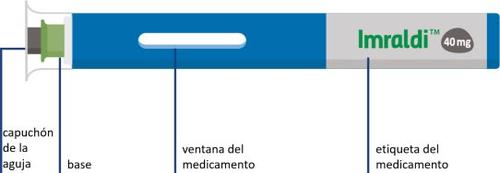
Your pre-filled pen does not have a button.
The needle is hidden under the green base. The injection will start automatically when you press the pre-filled pen firmly against your skin.
Caring for Your Pre-Filled Pen
Storage of the Pen
- Store the pen in the refrigerator, but do not freeze it.
- Keep the pen in its box and protect it from light.
- Keep the pen out of the sight and reach of children.
Disposal of the Pen
- Use each pen only once. Never reuse a pen.
- Dispose of the used pen in a special container as instructed by your doctor, nurse, or pharmacist.
Precautions
- If the pen has fallen with the cap on, you can still use the pen.
If the pen has fallen without the cap, do not use it. The needle may be dirty or damaged.
- Do not use a damaged pen.
Caring for the Injection Site
- Choose a fatty area for the injection
Fatty areas, such as the abdomen, are generally the best places for the injection. Fatty areas are good for inserting the needle correctly.
- Use a different place for each new injection
When choosing an injection site, select a site that you have not used recently so that it does not hurt or bruise.
How to Inject with Your Pre-Filled Pen
- Gather the Necessary Materials for the Injection
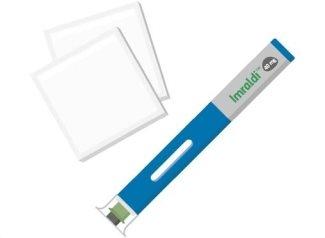
Place the pre-filled pen and the alcohol swabs on a clean and dry surface.
- Don't forget to wash your hands!
- Don't remove the cap yet!
- Wait for 15-30 Minutes
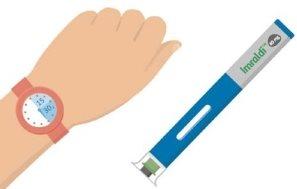
Wait for 15-30 minutes to allow the pre-filled pen to reach room temperature; this helps reduce the pain during the injection.
- Don't remove the cap yet!
- Check the Medication and Expiration Date
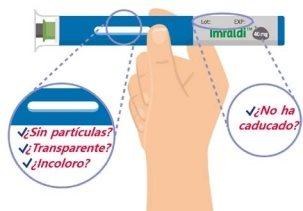
Always make sure that the medication is transparent to opalescent, colorless to pale brown, does not contain particles, and has not expired. If the medication is not transparent to opalescent, colorless to pale brown, contains particles, or has expired, do not use it.
You may see one or more air bubbles; this is normal and not a reason to discard the medication.
- Don't remove the cap yet!
- Choose an Injection Site and Clean the Skin
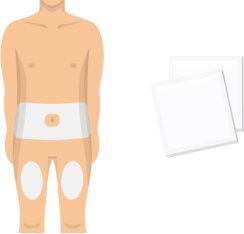
Choose an injection site on your body. The most suitable areas are the abdomen (except for the area around the navel) and the thighs.
Clean the injection site with an alcohol swab. Do not touch the area again before the injection.
- Avoid areas of the skin that are painful, bruised, scarred, scaly, or red.
- Remove the Transparent Needle Cap
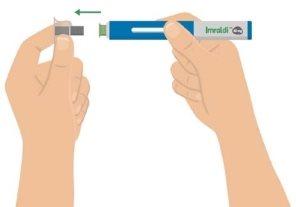
Remove the transparent needle cap from the pen carefully.
It is normal for a few drops of liquid to come out of the needle.
If you remove the needle cap before you are ready to inject, do not put it backbecause you could bend or damage the needle. You could accidentally prick yourself or waste the medication.
- Place the Green Base, Press, and Hold
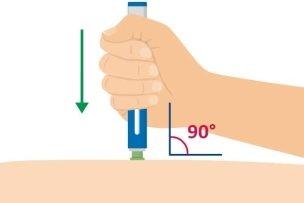
Place the green base vertically (at a 90-degree angle) on the skin and press the pre-filled pen down firmly to start the injection.
The injection starts when you press down. You may hear a first click.
- Hold the Pressure
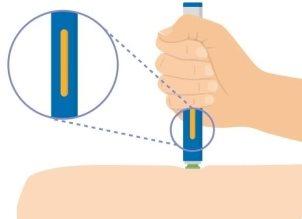
Hold the pen against the skin until the yellow indicator fills the medication window and stops moving.
A few seconds later, you may hear a second click.
- Confirm Completion and Dispose
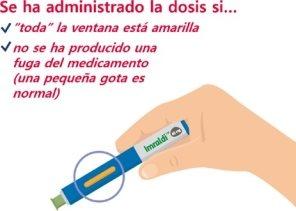
After injecting the Imraldi medication, confirm that the entire window is yellow.
Dispose of the used pen in a special container as instructed by your doctor, nurse, or pharmacist.
Are you unsure if you have administered your full dose? Contact your doctor, nurse, or pharmacist.
- Country of registration
- Active substance
- Prescription requiredYes
- Manufacturer
- This information is for reference only and does not constitute medical advice. Always consult a licensed doctor before taking any medication. Oladoctor is not responsible for medical decisions based on this content.
- Alternatives to IMRALDI 40 mg SOLUTION FOR INJECTION IN PRE-FILLED PENDosage form: INJECTABLE, 20 mgActive substance: adalimumabManufacturer: Amgen Europe B.V.Prescription requiredDosage form: INJECTABLE, 20 mgActive substance: adalimumabManufacturer: Amgen Europe B.V.Prescription requiredDosage form: INJECTABLE, 40 mgActive substance: adalimumabManufacturer: Amgen Europe B.V.Prescription required
Alternatives to IMRALDI 40 mg SOLUTION FOR INJECTION IN PRE-FILLED PEN in other countries
The best alternatives with the same active ingredient and therapeutic effect.
Alternative to IMRALDI 40 mg SOLUTION FOR INJECTION IN PRE-FILLED PEN in Україна
Online doctors for IMRALDI 40 mg SOLUTION FOR INJECTION IN PRE-FILLED PEN
Discuss dosage, side effects, interactions, contraindications, and prescription renewal for IMRALDI 40 mg SOLUTION FOR INJECTION IN PRE-FILLED PEN – subject to medical assessment and local rules.



